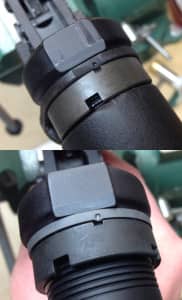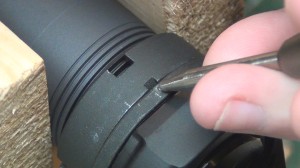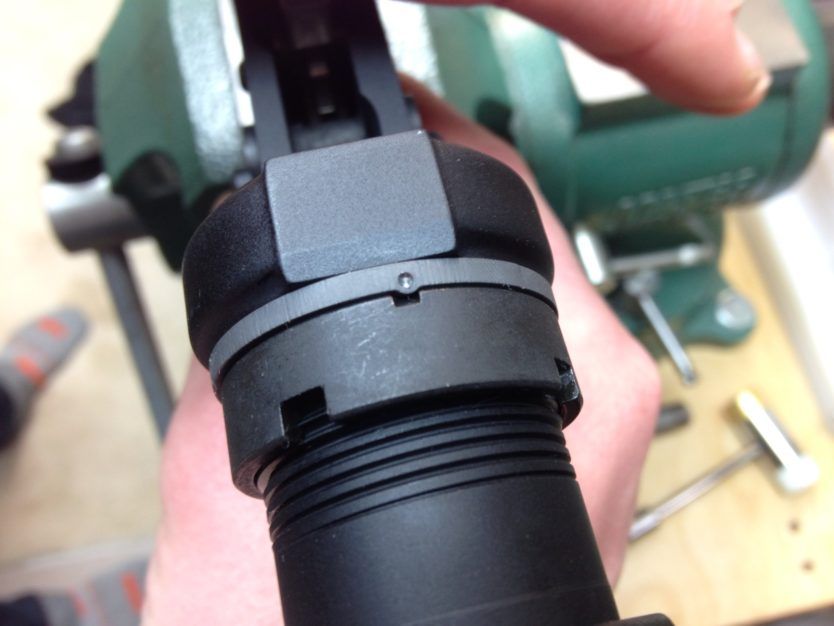Staking Your AR-15 Castle Nut
Why is staking a castle nut so important? Why can’t I use blue thread lock?” That is something people often ask me about building an AR-15. I have found that a large number of people with whom I have spoken do not realize the importance of staking the castle nut on their AR-15. I am a big proponent for staking a castle nut and will always do it on any AR-15 variant that I build for myself or others.
What is a Castle Nut

But let’s back up a minute, what is the “castle nut” and what does it do? A castle nut, also referred to as a buffer tube nut, is a circular, notched nut that screws onto the AR-15 lower receiver extension (buffer tube) and keeps the receiver extension and lower receiver end plate secured in place.
On a standard mil-spec castle nut, one side will have large notches that look like little squares have been cut out of it (hence the nickname because it resembles the top of a castle tower). On the other side, there are smaller notches or indents, which should be facing the receiver end plate when correctly installed. These smaller notches are there and have been designed explicitly for staking purposes.
Why Stake Your Castle Nut
Not staking the castle nut on your AR-15 is taking quite a considerable risk. Many people, myself included, own an AR-15 for self-defense purposes because of its proven reliability and accuracy. By not staking your castle nut, you reduce the overall reliability of your AR-15 and, in turn, introduce a higher probability of a catastrophic failure.
Take a moment and consider the following scenario. Say you chose not to stake the castle nut on your AR-15, and after some range time, the castle nut becomes loose. That causes the endplate to become loose. Once the end plate is loose, the takedown pin spring and detent can fall out. Now, the receiver extension can move, which means it will no longer hold the buffer retainer in place, so your buffer and buffer spring can’t stay in place. All of this can happen in just a second or after few shots without you even noticing. That is, until either your AR-15 explodes or the receiver extension breaks apart—both of which would render your AR-15 completely inoperable.
“My AR-15 could explode? Ha, that’s doubtful.” Not necessarily. All it takes is for the buffer retainer to become trapped somewhere in the upper receiver to prevent your bolt from fully seating, which can make a round go off inside the receiver but not in the chamber. That is especially true with AR-15 style bolt carriers instead of M-16 bolt carriers because of the typical lightning cut.
Many have told me that they “have used blue thread lock on the castle nut and have never had a problem in all their years of shooting AR-15s.” My response to them is to remind them that something catastrophic will likely not have convenient timing. Why take the chance and allow the dangerous possibility of that catastrophic failure? You don’t want your AR-15’s stock to fall off.
How to Stake Your Castle Nut

You can avoid all of this trouble by taking roughly 60 seconds to stake your castle nut properly. Follow these simple steps:
- Make sure that you have correctly installed your castle nut at 40-foot pounds of torque on the receiver extension with the small notches facing the receiver end plate.
- Using either a spring-loaded center punch or a standard center punch and a hammer, place the tip of the punch onto the lower receiver end plate that is in line with a small staking notch on the castle nut.
- Using force, manipulate enough material from the endplate into one (or two) of the small notches on the castle nut. That will render the castle nut properly staked and semi-permanent.
Check out our list of the best buffers for your AR-15.


